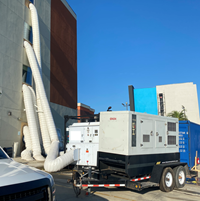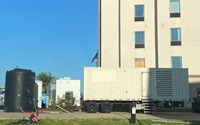Portable Generators During Natural Disaster Recovery
Following a large natural disaster, like Hurricane Laura, speed is of the absolute essence to restore basic services and prevent additional damage to structures and facilities. These storms can damage roofs, tear open exterior walls, push debris (such as tree limbs) into buildings, create flooding or storm surge, disrupt local utilities, and/or destroy external structures. In wind and water events, the structural integrity of buildings is often comprised, opening the opportunity for additional water to cause further damage. The longer that the structure remains open to the elements, the worse the damage becomes.
As the armies of emergency workers, insurance adjusters, reclamation firms, and utility crews flood into a  disaster zone restoring power is a pressing requirement to enable many other operations (after preservation of life and prevention of theft / looting). Linemen and utility companies focus on safely returning the electrical grid by clearing debris, repairing lines, and clearing dangerous situations. During the grid outage, diesel generators are used to provide temporary power for a variety of tasks. Generator Source's premier team has supplied diesel generators to such organizations in trying times of strife.
disaster zone restoring power is a pressing requirement to enable many other operations (after preservation of life and prevention of theft / looting). Linemen and utility companies focus on safely returning the electrical grid by clearing debris, repairing lines, and clearing dangerous situations. During the grid outage, diesel generators are used to provide temporary power for a variety of tasks. Generator Source's premier team has supplied diesel generators to such organizations in trying times of strife.
Standby Natural Gas, Diesel, & Portable Generators
In the prepared locations and organizations, permanently installed diesel and natural gas generators can be immediately put to work upon reoccupation. When paired with an automatic transfer switch (ATS), backup generators can sense the grid outage and automatically begin powering the facility. Widespread flooding may hamper automatic operation of generators, especially if the generator and distribution equipment is not properly elevated. Locations with sufficient generator capacity can quickly return their focus to core operational tasks.
When permanent backup generators do not exist or are not sufficient, organizations bring in temporary rental generators to power a variety of tasks, including:
- Temporary housing / command centers - when emergency workers and restoration teams arrive in a disaster area, they need a place to work from. Portable generators can be hooked up to undamaged buildings, such as hotels, to provide shelter, a place to coordinate from, and protection from the elements. More mobile teams may work out of RVs (recreational vehicles) powered by smaller portable generators or using a single trailer mounted generator to power multiple RVs.
 Government agencies, such as FEMA or the National Guard may set up tents or trailers requiring power. Larger power module generators (gensets in ISO containers) may be brought in to power hotels or casinos. Smaller RV-based command centers may utilize hand portable generators, like the Champion 9 kW or Briggs & Stratton 4.5 kW, to power air conditioning and lighting.
Government agencies, such as FEMA or the National Guard may set up tents or trailers requiring power. Larger power module generators (gensets in ISO containers) may be brought in to power hotels or casinos. Smaller RV-based command centers may utilize hand portable generators, like the Champion 9 kW or Briggs & Stratton 4.5 kW, to power air conditioning and lighting.
- Emergency water (including toilets / showers) - as soon as people return to the disaster area, water for drinking, cleaning, bathing, and bathrooms is an immediate need. Portable generators can power the pumps, lighting, and purification systems needed to care for people before the utility water system is fully operational. Emergency crews bring in water reclamation equipment, such as the Water Fleet Water Rig, to provide potable water while boil notices exist for utility water.
- Drying units - Recovery firms use desiccant machines and air movers (large industrial fan systems) to remove moisture from flooded or damaged buildings. This drying process is conducted in conjugation with contractors temporarily (e.g., covering damaged roof with tarps) or permanently repairing the structure to prevent additional rain from coming in.
- Supplemental HVAC - When permanent heating and air conditioning equipment is damaged or unavailable, recovery teams may bring in containerized HVAC units to heat or cool buildings during the recovery effort. These power hungry HVAC units require substantial portable or diesel generators to power them.
- Mobile lighting - The nights after a disaster can be very dark as street lights and other ambient
 lights remain off. Mobile lighting units increase safety at key road intersections and in areas where emergency crews are staying. This temporary lighting can also help reduce theft in damaged commercial buildings.
lights remain off. Mobile lighting units increase safety at key road intersections and in areas where emergency crews are staying. This temporary lighting can also help reduce theft in damaged commercial buildings.
- Communications nodes - Generators are used to power both existing cellular phone towers as well as mobile telecom equipment that is brought into the area. These units allow recovery workers to more easily communicate within teams and with outside assets.
Getting a portable generator on-site is the first part of restoring power but a few other key items to consider include:
- Moving generator to use location - Once the generator has arrived in the general facility a large
 pickup truck or forklift may be needed to move the unit to it's operational location. Portable generators on trailers make this task easier but generators larger than 100 kW may require a heavy duty vehicle.
pickup truck or forklift may be needed to move the unit to it's operational location. Portable generators on trailers make this task easier but generators larger than 100 kW may require a heavy duty vehicle.
- Distribution from generator to end user - After getting the generator to it's operating location, distribution cables will need to be run from the generator to the area where power will be used. This might be large cables running to a manual transfer switch or smaller cables running local distribution boxes (lovingly called spider boxes) for end users. This task is generally accomplished by an electrician, with special care to ensure the natural gas, diesel, or portable generator isn't back feeding to the local utility.
- Fuel for generator - Rental generators are generally shipped with minimal fuel so the end customer will need to establish a solution for diesel. As the generator runs, it will be important to fill the diesel tank regularly. Fuel consumption varies by engine size and electrical load on the generator. Fuel companies, such as Sun Coast, often set up emergency fuel distribution networks to enable the use of diesel generators after a disaster. Portable natural gas generators, such as the Mesa 350 kW, can be connected to the utility natural gas connection and run like any other portable generator.
- Generator maintenance - Like any engine, running the generator's engine will eventually require maintenance. For short-term use (<1 week), the rental company will generally take care of this maintenance. In longer, constant use scenarios, field technicians may need to perform oil changes at the job site to keep the generator operational.
Kyle Smith
| 9/21/2020 2:29:39 PM
|
0 comments